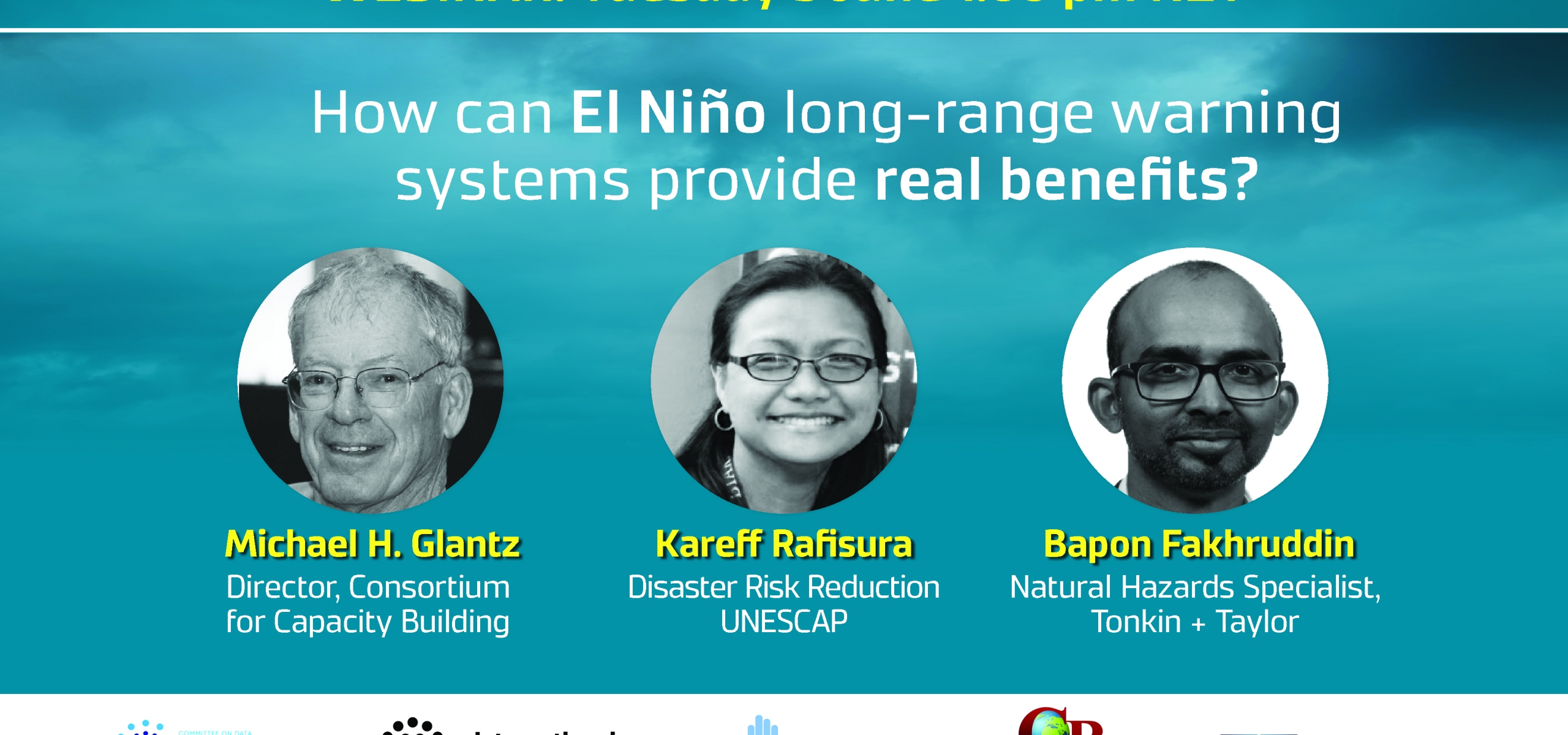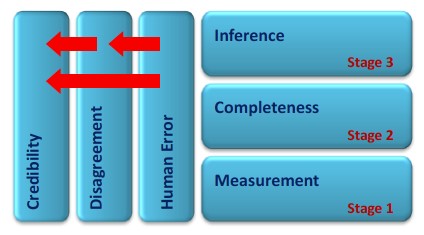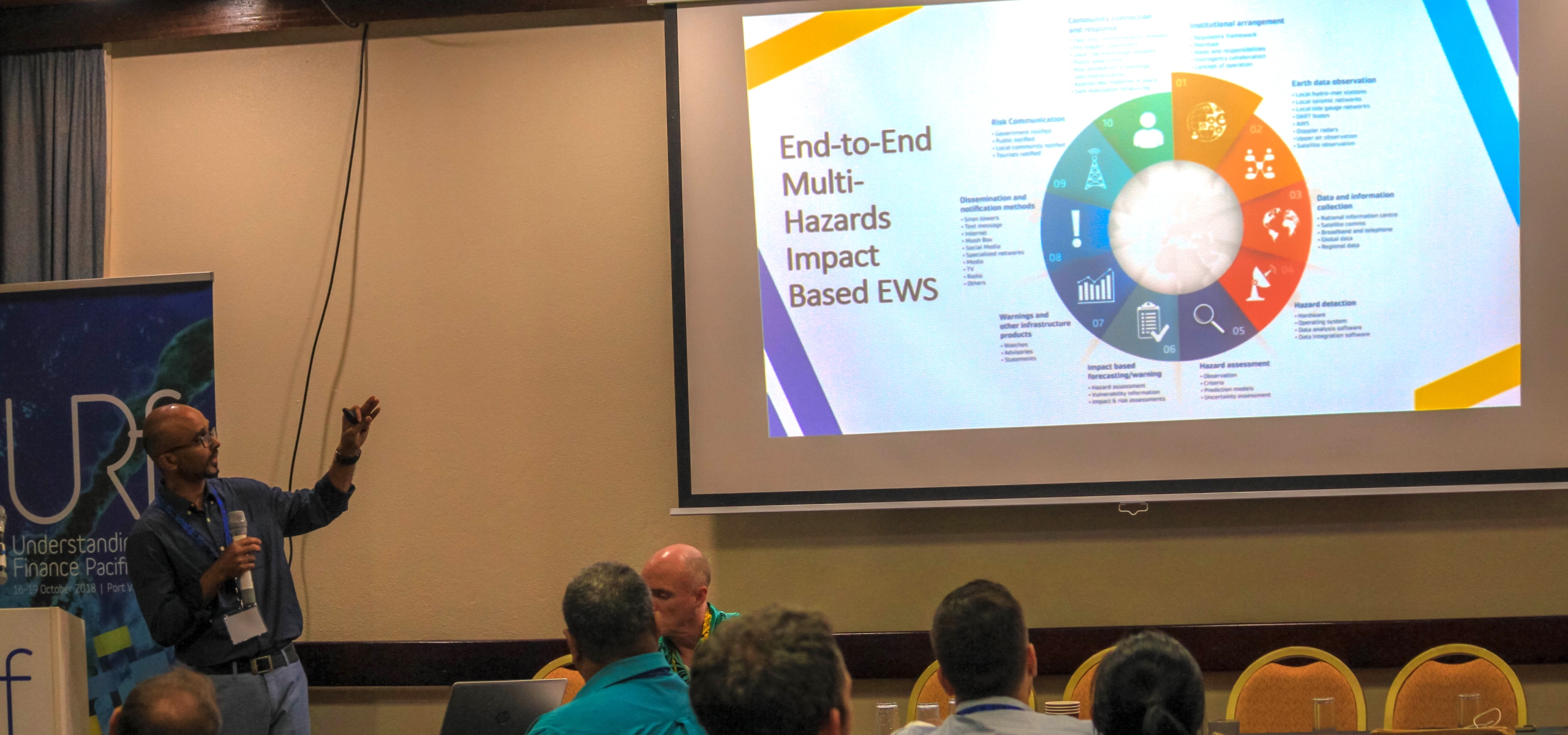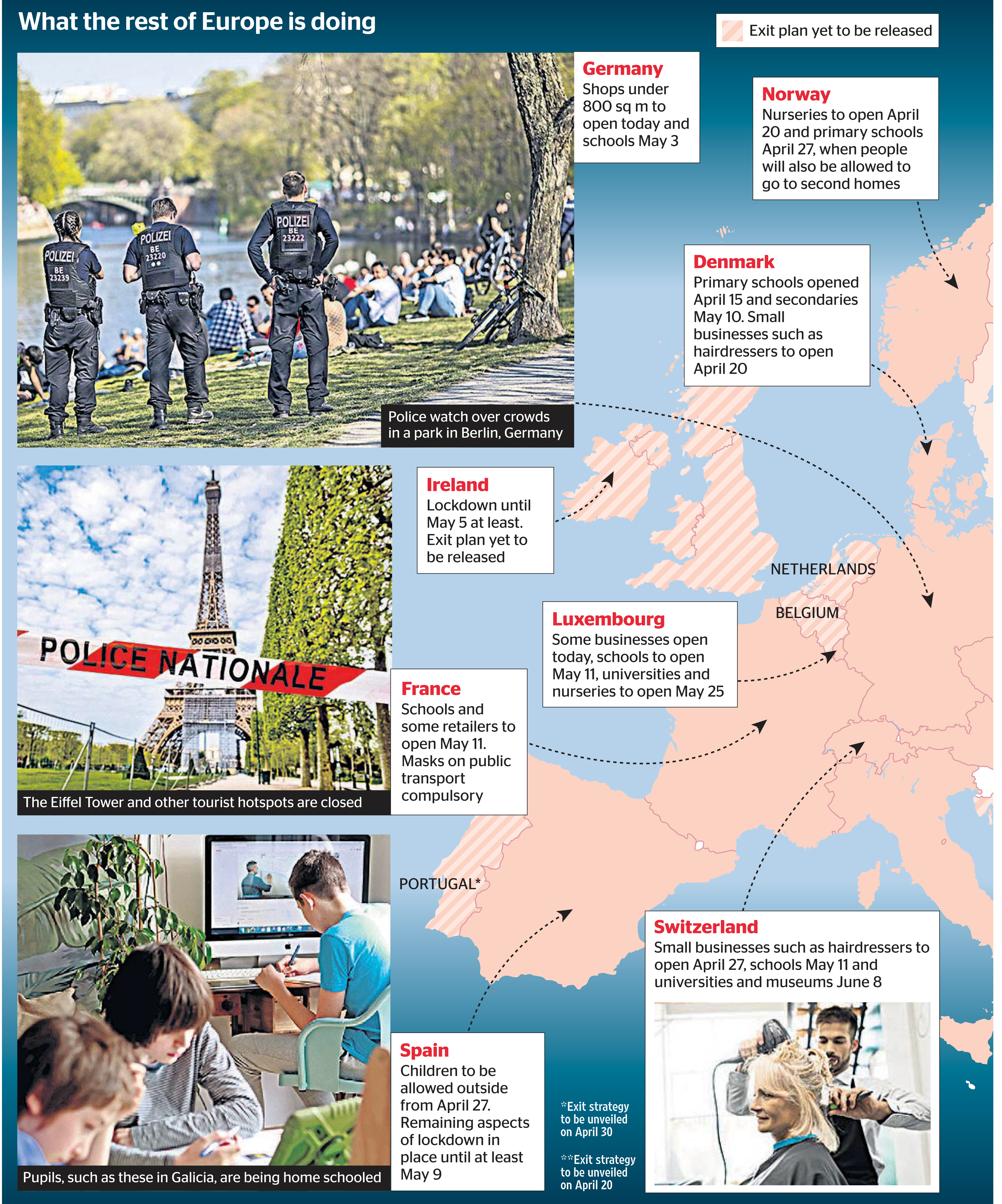
Currently many countries are experiencing severe drought. Could the impacts of drought have been minimised with an effective long-range warning system (LRWS)?
Three-stage warning systems that conduct short, medium and seasonal forecasting can prepare industries and communities for both severe weather events and the impacts of El Niño. When ocean conditions suggest that an El Niño may be forming, long range warnings can be issued, allowing industries and communities to respond and become more resilient.
Tonkin + Taylor in partnership with Integrated Research on Disaster Risk (IRDR), Committee on Data (CODATA) of the International Science Council (ISC), have brought together three of the world’s leading Disaster Risk Reduction experts Bapon Shm Fakhruddin, PhD, Mickey Glantz and Kareff Rafisura to share how LRWS could help communities and industries prepare for severe weather events and the impacts of El Niño.
Click here to watch the webinar replay: https://www.youtube.com/watch?v=4lIsO-Aq5mg&t=3s

Webinar | Transition from response to recovery-Tuesday, 12 May 2020, 1 PM NZT (GMT+12)
Join us tomorrow as we bring some of the world’s leading disaster risk reduction experts together to discuss this pandemic –https://event.webinarjam.com/register/1/plpw4hx
They’ll be talking about how we transition from response to recovery in this pandemic. Given that disaster is what they do, they are uniquely qualified to talk about the recovery phase of the pandemic and share lessons learned from large-scale natural disasters.
A policy brief is on in-press, please follow the link https://authors.elsevier.com/tracking/article/details.do?aid=100102&jid=PDISAS&surname=Fakhruddin


Uncertainties in the COVID-19 impact assessment are inevitable. In order to understand various approaches to uncertainty and model implications, they need to holistically analyze. An inherently high level of uncertainty is associated with pandemic assessments derived with parametric approaches. While higher degrees of accuracy may be achieved with data-intensive based models, uncertainties are still associated with each step of the process. In particular, uncertainties exist in direct, indirect and long-term reversible impact estimates. Uncertainty in the development of a pandemic impact can stem from two sources: natural variability (stochastic) and knowledge uncertainty (epistemic).
Science is full of epistemic uncertainty. Circling the unknowns, inching toward truth through argument and experiment is how progress is made. As the world gets back on its feet after sinking for COVID-19 and more and more reliable data comes in the COVID-19 pandemic, risk communication is rapidly becoming a constrained problem. Risk is yet another type of uncertainty, usually pertaining to things in the future that might turnout badly. Risk encompasses the known unknowns and can be calculated with probabilities. Risk governance for COVID-19 needs to provide a balance between risk assessment, risk management, and risk communication.
A framework is established on a (modified) hierarchy and connectivity among six types of differentiated uncertainties including measurement, completeness, inferences, disagreement, credibility and human error. In general, the process used to solve a problem of interest can be described in three stages, where each stage is associated with i) a more advanced state of data processing and ii) one of the six types of uncertainties expressed in the stages. Uncertainties relating to disagreement, credibility, and human error are considered at all three stages which are data acquisition (measurement), data sorting and manipulation (completeness) and data transformation to address objectives (inference).

More could be found in the detail paper!
Read April 2020 Edition of our DRR and Data Newsletter on behalf of Disaster DATA Working Group of Integrated Research on Disaster Risk(IRDR) programme of ICS/UNISDR, CODATA task group Linked Open Data for Global Disaster Risk Research (LODGD), SustainableDevelopment Solution Network, Public Health England and Tonkin+Taylor. Feel free to subscribe!

With golden sands, azure-hued waters and temperature averages sitting nicely in the mid-20s, the island nation of Dominica in the Caribbean is a picturesque paradise you’d see on a postcard or a screensaver.
It’s Dominica’s tropical location that gives it its paradise-like qualities. That same location however, leaves Dominica prone to hurricanes, high-wind, high-rainfall, earthquakes, volcanic eruptions and tsunamis.
On September 18 2017, Hurricane Maria struck Dominica, leaving $1.37 billion in losses across the island, equal to 226 times its 2016 GDP. 65 lives were claimed in its wake – the deadliest hurricane in Dominica in over 150 years.
While hurricanes can’t be prevented, a sufficient early warning system can provide ample forewarning to help mitigate damage to infrastructure and reduce loss of life.
“It’s been three years since Hurricane Maria hit Dominica”, says Tonkin + Taylor’s Bapon Fakhruddin. “People are still awaiting assistance to repair their homes and there’s not much in the way of improvement”.
Tonkin + Taylor’s Bapon Fakhruddin is one of the world’s pre-eminent leaders in disaster risk reduction and early warning systems (EWS) and has just been tasked by the United Nations Development Programme for Dominica to help produce Dominica’s new multi-hazard impact based early warning system, in conjunction with the Dominica Meteorological Service and Office of Disaster Management.
“Post-Hurricane Maria, several EWS initiatives were put in place in Dominica but they lack consistency, standardisation or harmonisation”, says Bapon. “I’m designing a new system based on user need and local context to help reduce life and property damage”.
Early warning systems are a major element in disaster risk reduction through the emphasis on disaster preparedness. Despite considerable advances in predictive technologies, hydro-meteorological and geo-hazards continue to claim many thousands of lives while wreaking irreparable damage upon homes, businesses and critical infrastructure. This continuously results in leaving impoverished economies in their destructive wake.
Implementation of the early warning system is close and Bapon sees further collaboration as integral to the process:
“Developing the multi-hazard early warning system is an iterative and evolving process that needs to be undertaken in close communication with stakeholders. We have sent through our design. Now it’s over to the Government to ensure the system is integrated and harmonized to save lives and reduce damages from future disaster.

Cyclone early warning systems are the primary sources of information that enable people to develop a preparedness strategy to mitigate the hazards of cyclones to lives and livelihoods. In Bangladesh, cyclone early warnings have significantly decreased the number of cyclone related fatalities over the last two decades. Nevertheless, several challenges remain for existing early warning services (EWS), urging for both technical and non-technical improvements in the said services. Given limited financial resources, the economic efficiency assessment of the improvement is highly important. Therefore, this study aims to estimate the willingness to pay (WTP) for improved warning services by considering the at-risk households’ trade-off between proposed improved EWS and existing EWS in coastal Bangladesh. Applying systematic random sampling, 490 respondent households were selected from Khulna, Satkhira, and Barguna districts, with whom a choice experiment (CE) was performed. The CE was designed by incorporating impact-based scenarios for improved EWS. As analytical tools, Conditional and Mixed-Logistic regression models were used that derived the WTP for improved EWS attributes. Empirical results show that the WTP of an at-risk household for improved EWS was estimated at Bangladeshi Taka BDT 468 (≈ US$ 5.57) per year, implying respondents were ready to pay for the improvement of the warning attributes, including precise information of the cyclones landfall time with possible impacts, more frequent radio forecasts, and voice messages in the local dialects over mobile phones. A revenue stream for improved EWS was developed, implying investments in EWS would be a no-regrets approach. This study concludes with four policy recommendations on mitigating the existing challenges for improving EWS in Bangladesh.
Full paper could be download from here https://www.sciencedirect.com/science/article/pii/S2590061720300028

The Understanding Risk Finance Pacific Forum was recently held in Vanuatu, with policymakers, financial risk managers and development partners from the region and around the globe converging upon Port Vila to strengthen regional collaboration in the Pacific.
Co-organised by the Government of Vanuatu’s Ministry of Finance and Economic Management (MFEM) and the World Bank’s Disaster Risk and Insurance Program (DRFIP), the URF Pacific Forum was conducted over four days with discussion and in-depth sessions focusing on technical, policy and interactive training, showcasing innovative approaches to government action, community engagement and private sector solutions.
Two key themes and three key objectives were identified in order to create lasting change in the Disaster Risk Reduction space:
Themes:
- Understanding Risk – improving the way in which risk information is gathered, analysed and communicated.
- Building Financial Resilience – planning ahead to better manage the financial and humanitarian impact of disasters.
Objectives:
- Strengthen collaboration – on climate and disaster risk finance among Pacific Island Countries (PIC) and across Small Island Developing States (SIDS).
- Provide opportunities for knowledge exchange among countries and between regional organisations.
- Capture best practices and identify collaboration on disaster risk finance and insurance among PICs and global partners.
Tonkin + Taylor’s Technical Director of DRR and Climate Resilience, Dr Bapon Fakhruddin, was present at the Forum, acting as Speaker on Pacific Early Warning Systems (EWS) in a session on Multi-Hazard Impact Based Early Warning Systems.
“Science has made advancements but we have not yet been able to incorporate advanced science in operational decision making”, Dr Fakhruddin says. “Many of the operational forecasting information is still not able to reach the area of the community at risk”.
Early warning systems are a major element in disaster risk reduction through the emphasis on disaster preparedness. Despite considerable advances in predictive technologies, hydro-meteorological and geo-hazards continue to claim many thousands of lives while wreaking irreparable damage upon homes, businesses and critical infrastructure. This continuously results in leaving impoverished economies in their destructive wake.
In recent years, it has become clear that sustained and efficient investment in multi-hazard early warning systems is vital. This is particularly relevant in Least Developing Countries (LDCs) and Small Island Developing States. Along with this, the need to strengthen access and availability to early warnings is also reiterated in the Sendai Framework, the Paris Climate Change Agreements and the 2030 Agenda for Sustainable Development.
An early warning is the provision of timely and effective information. This can be delivered through identified institutions, which then inform individuals exposed to hazard to take action to avoid or reduce their risk and prepare for effective response. The integration of each element with equal strength is critical for the success of the EWS. One weak element can cause failure of the overall system.
Reflecting on the URf, Dr Fakhruddin says, “When communicating warnings, the information suppliers need to use language that is not overly technical or scientific. The suppliers need to keep the audience of the warnings in mind, including their level of understanding and knowledge, to ensure maximum clarity is achieved”.






Recent Comments